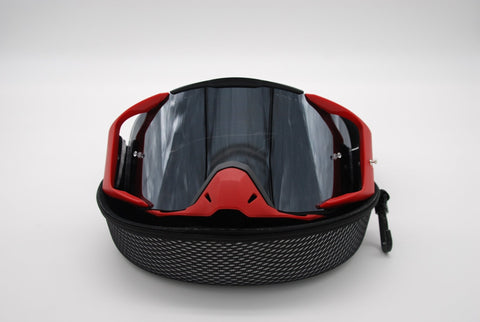Choosing the Right Goggle for your Needs
Goggles are a crucial piece of gear for anyone participating in outdoor activities, whether it be motocross, snowboarding, or skiing. Not only do goggles provide essential protection for your eyes, but they also help improve visibility and comfort. However, not all goggles are created equal, and it's essential to select the right type of goggles for your specific needs.
In this post, we will be comparing motocross and snow goggles, discussing the key differences between the two and which one to choose for your particular activity. While both types of goggles share some similarities, such as their primary function of protecting your eyes from harmful UV rays, they differ significantly in design, fit, and functionality.
By understanding the differences between motocross and snow goggles, you'll be able to make an informed decision when choosing the right goggles for your next outdoor adventure. So, let's dive in and explore the differences between these two types of goggles.
Differences in Design and Fit:
One of the most apparent differences between motocross and snow goggles is their design and fit. Motocross goggles are designed to fit tightly against the rider's face to prevent dirt, dust, and debris from entering the goggles while riding. They also have a wider field of vision to help riders navigate through rough terrain and obstacles.
On the other hand, snow goggles have a larger frame and are designed to fit over a helmet comfortably. They are designed to keep snow, wind, and glare out of your eyes while riding on the mountain. Additionally, snow goggles usually have a dual-lens design that helps prevent fogging in cold and wet conditions.

When it comes to the fit, motocross goggles have a single strap that goes around the back of the rider's head to keep them securely in place. Snow goggles, on the other hand, usually have an adjustable strap that goes around the back of the helmet to ensure a secure fit over the helmet.
Overall, while both types of goggles provide protection for your eyes, they differ significantly in their design and fit. Motocross goggles are designed for a tight fit to prevent dirt and debris from entering the goggles, while snow goggles are designed for a more comfortable fit over a helmet to protect against snow, wind, and glare.
Differences in Lens Tint:
Another significant difference between motocross and snow goggles is the lens tint. Lens tint is an essential factor to consider when choosing between these two types of goggles, as they have different lighting conditions.
Motocross goggles typically have a clear lens that allows for maximum visibility in different lighting conditions. Clear lenses are perfect for low-light conditions or when riding in shaded areas. However, some motocross goggles come with tinted lenses that provide better vision on bright, sunny days.
On the other hand, snow goggles come with lenses that have different tints, including yellow, rose, and gray. The lens tint you choose depends on the weather conditions you expect to encounter while riding on the mountain. Yellow lenses are best for low-light conditions, while rose lenses are ideal for overcast days. Gray lenses are perfect for sunny days as they reduce glare and eye strain.
Overall, the lens tint is an important factor to consider when choosing between motocross and snow goggles. Motocross goggles typically have clear lenses with the option of tinted lenses, while snow goggles come with lenses of different tints to suit different lighting conditions.
Differences in Lens Shape and Size:
Another difference between motocross and snow goggles is the lens shape and size. Snow goggles usually have a larger lens with a spherical or cylindrical shape that provides a wide field of vision. The large lens size is beneficial when snowboarding or skiing as it allows the rider to see their surroundings better and react quickly to obstacles.
Motocross goggles, on the other hand, typically have a smaller lens size that fits tightly against the rider's face. The smaller lens size reduces the risk of debris or dirt getting into the rider's eyes, which can be dangerous during high-speed rides.
Additionally, the shape of the lens is different between motocross and snow goggles. Snow goggles have a spherical or cylindrical shape that curves both horizontally and vertically to provide a wide field of view. In contrast, motocross goggles have a flatter lens shape that curves horizontally to provide better clarity when looking ahead.

Overall, the lens shape and size of motocross and snow goggles differ, with snow goggles having larger spherical or cylindrical lenses that provide a wide field of vision, while motocross goggles have smaller flat lenses that fit tightly against the face to prevent debris from getting into the rider's eyes.
Other Considerations When Choosing Goggles:
When choosing between motocross and snow goggles, there are a few other factors that you should consider to ensure that you are getting the right goggles for your needs.
-
Ventilation: Both motocross and snow goggles require proper ventilation to prevent fogging. However, motocross goggles tend to have more airflow due to the faster speeds involved in motocross riding. Snow goggles also have ventilation systems, but they are designed to prevent snow and cold air from getting inside the goggles.
-
Durability: Motocross goggles are designed to withstand impacts from rocks, dirt, and other debris that may be kicked up during a race. Snow goggles are designed to withstand the elements, including snow, wind, and cold temperatures.
-
Compatibility with helmets: Both motocross and snow goggles should be compatible with your helmet. However, some helmets may have specific requirements, such as a certain shape or size of goggle. It's important to ensure that your goggles and helmet work well together to provide maximum protection and comfort.
-
Price: Motocross goggles tend to be less expensive than snow goggles, as they do not require the same level of technology and materials. However, both types of goggles can range in price depending on the brand and features.
By considering these factors, you can choose the right goggles for your needs and ensure that you have the best protection and performance on the track or on the slopes.
How to Choose the Right Goggles for Your Needs
Choosing the right goggles for your needs can be a daunting task, but with some knowledge and consideration, you can make an informed decision that will enhance your riding experience. Here are some tips on how to choose the right goggles for your needs:
-
Determine the type of riding you will be doing: Different types of riding require different types of goggles. Motocross goggles are designed for off-road use and have features such as tear-offs, anti-fog coatings, and venting systems. Snow goggles, on the other hand, are designed for cold weather and have lenses that are optimized for low-light conditions.
-
Consider the fit: Goggles should fit snugly on your face without causing discomfort or pressure points. Look for goggles that have adjustable straps and foam padding that conforms to the shape of your face.
-
Look for lens features: Different lenses have different features such as UV protection, anti-fog coatings, and polarization. Choose a lens that suits your needs and the conditions you will be riding in.
-
Consider lens tint: Lens tint affects the amount of light that is transmitted through the lens. Clear lenses are ideal for low-light conditions, while darker tints are better for bright conditions. Consider a lens with a tint that matches the conditions you will be riding in.
-
Look for durability: Goggles can take a beating during riding, so look for goggles that are durable and can withstand impact. Look for goggles with scratch-resistant lenses and a sturdy frame.
By considering these factors, you can choose the right goggles for your needs and have a more comfortable and enjoyable riding experience.
In conclusion, choosing the right goggles for your needs is crucial to ensure that you have a comfortable and safe riding experience. When it comes to choosing between motocross and snow goggles, there are distinct differences in design, fit, lens tint, and shape/size that should be taken into consideration. By understanding these differences and assessing your specific needs as a rider, you can make an informed decision on which type of goggles will best suit your needs. Remember to consider factors such as weather conditions, riding style, and personal preferences when making your decision. Whether you opt for motocross or snow goggles, investing in a high-quality pair of goggles will help you to see clearly and perform at your best on the track or slopes.

